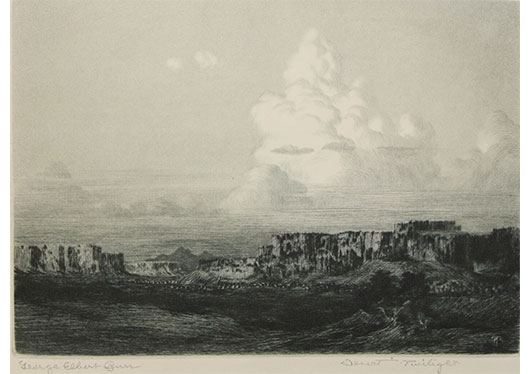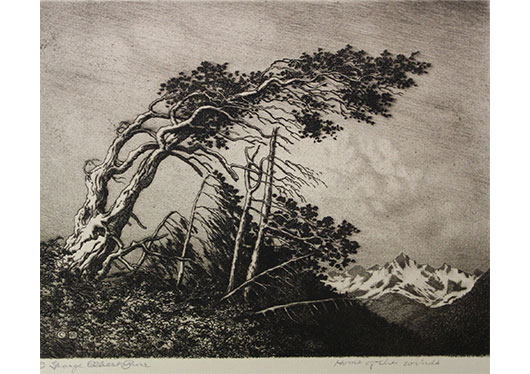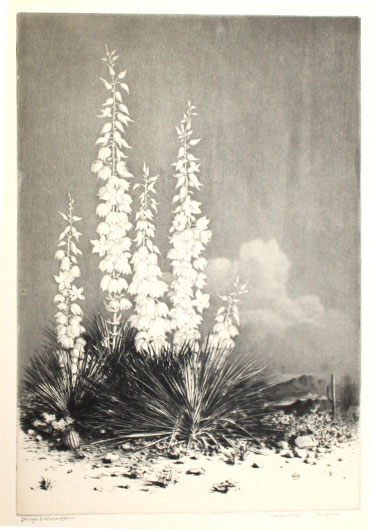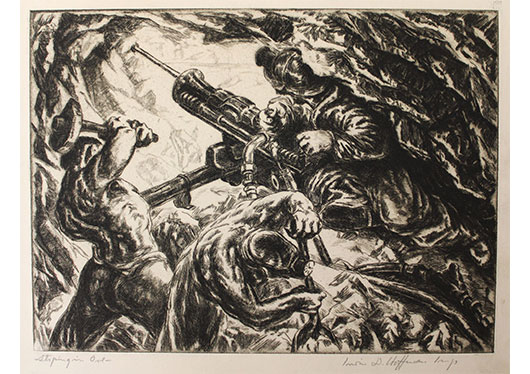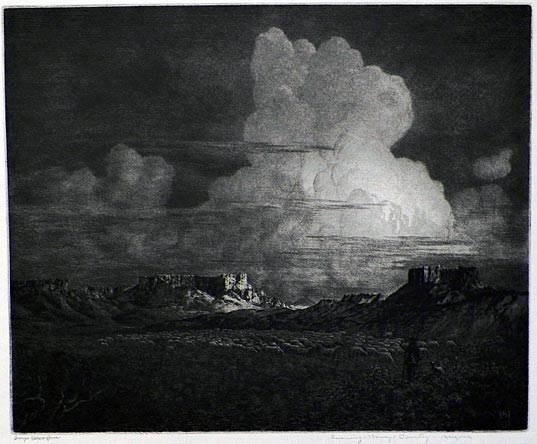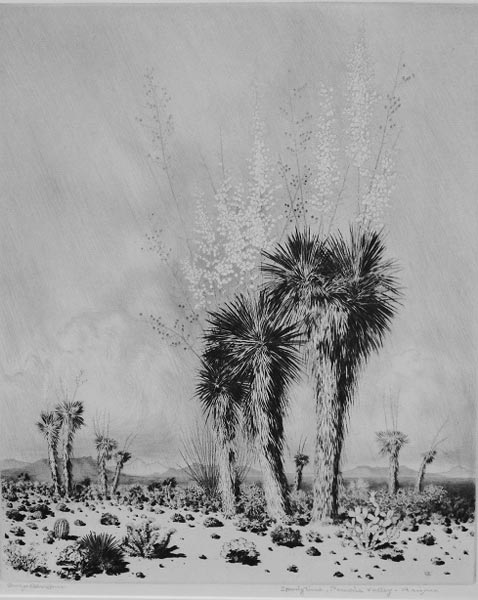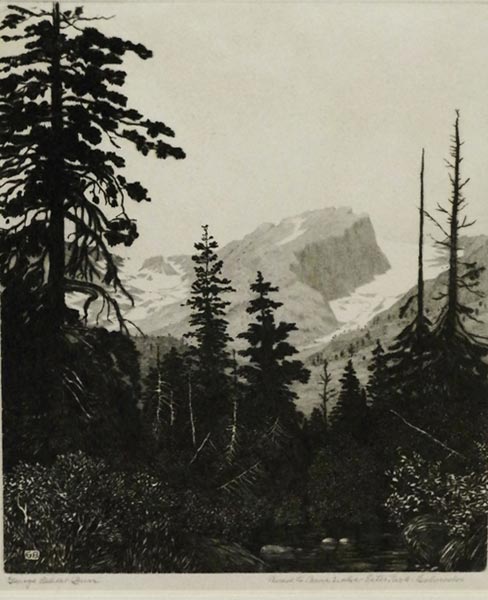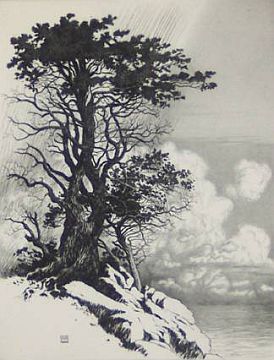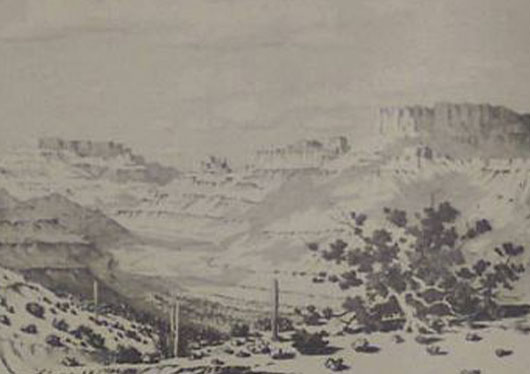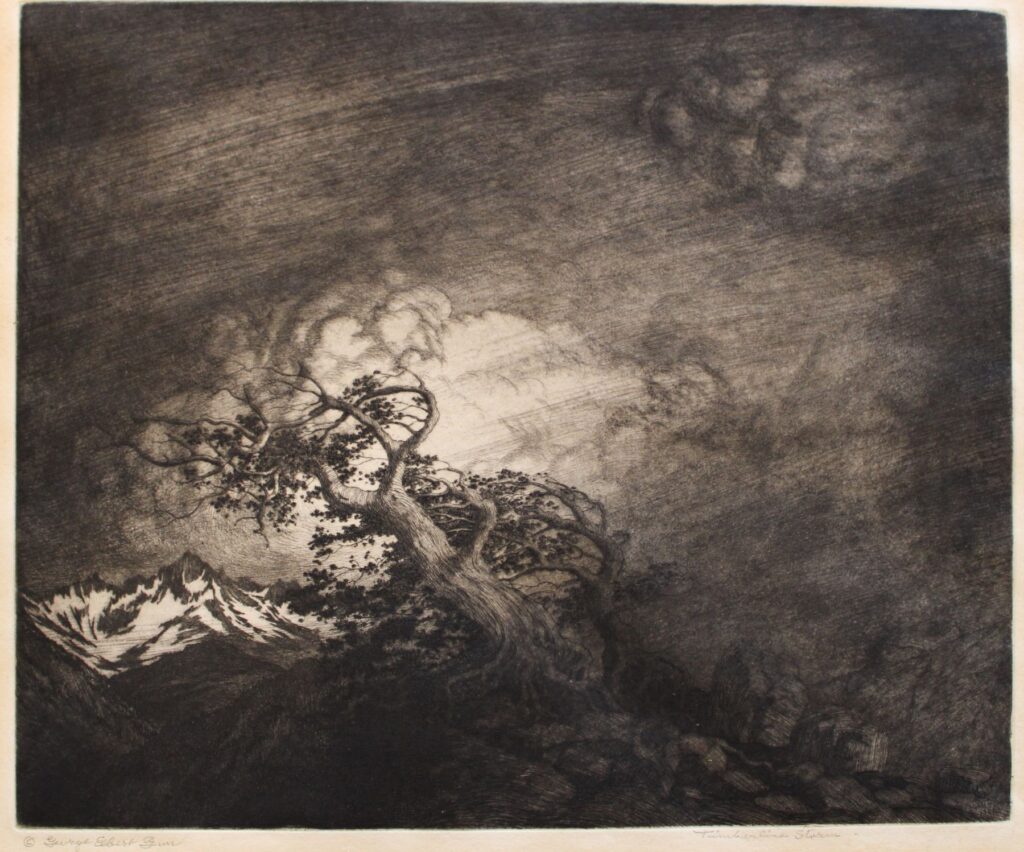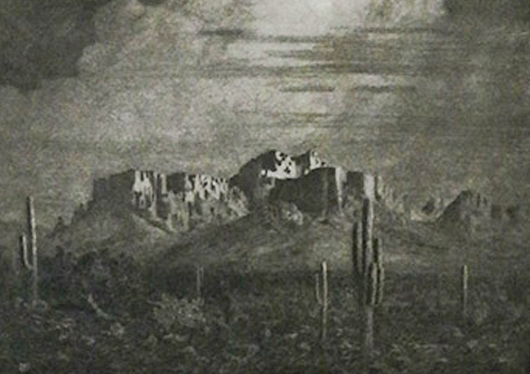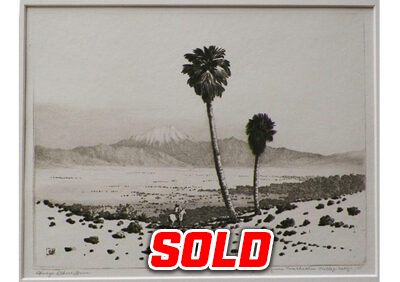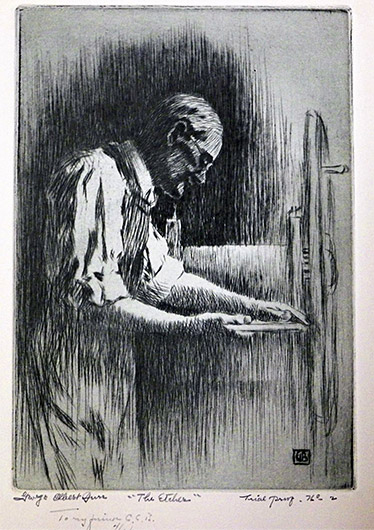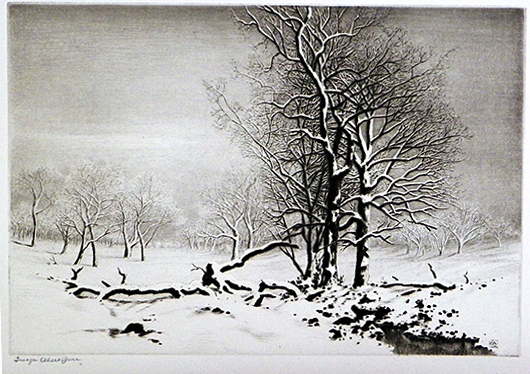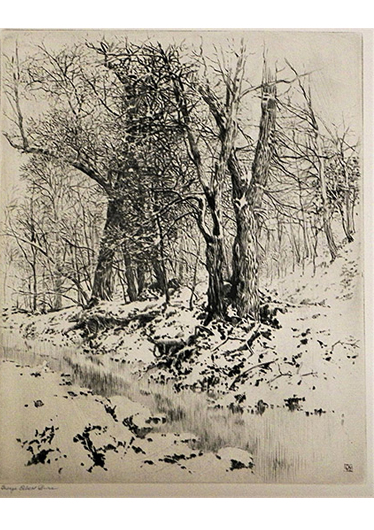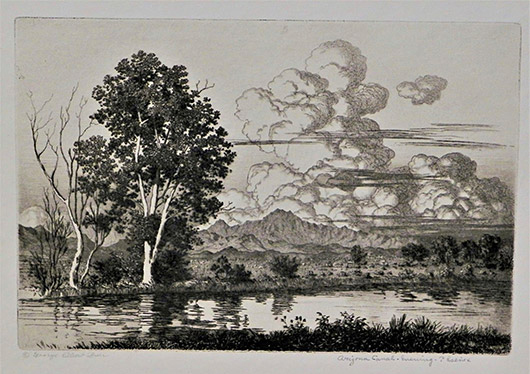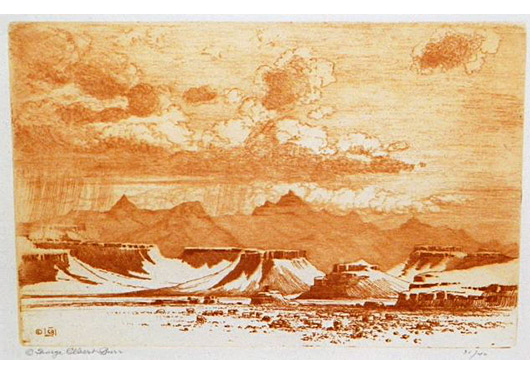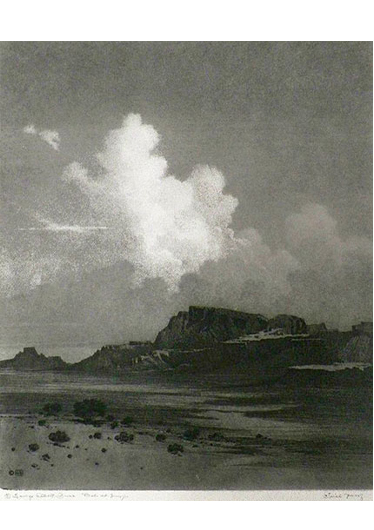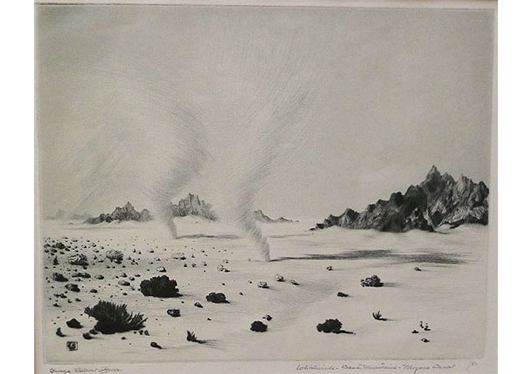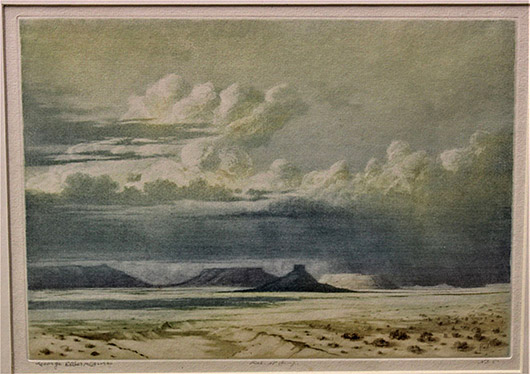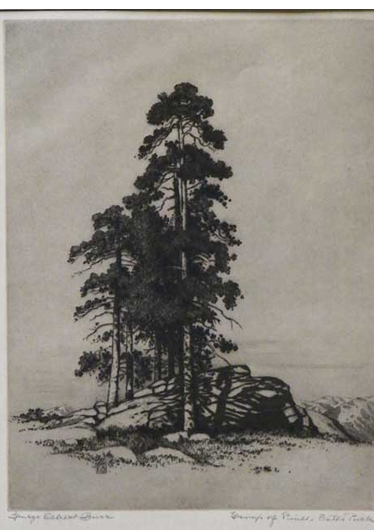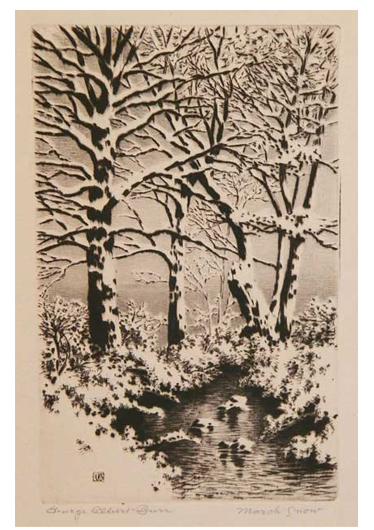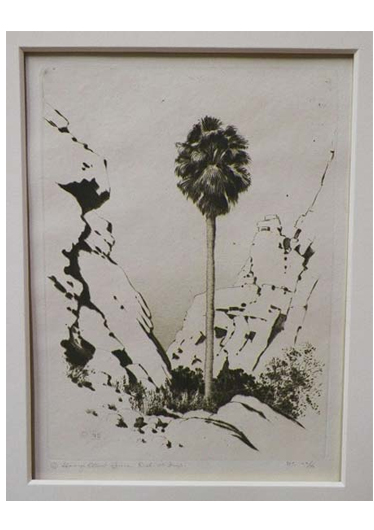Biographical information for George Elbert Burr.
Ten years after his birth in Monroe Falls, Ohio, George Elbert Burr moved with his parents to Cameron, Missouri, where his father opened a hardware store. Burr was interested in art from an early age and his first etchings were created with the use of zinc scraps found in the spark pan under the kitchen stove. He then printed the plates on a press located in the tin shop of his father’s store.
In December of 1878, Burr left for Illinois to attend the Art Institute of Chicago (then called the Chicago Academy of Design). By April of the following year, Burr had moved back to Cameron and the few months of study in Chicago constituted the only formal training the artist was to have.
Back in Missouri, Burr heeded his family’s wishes by working in his father’s store. However, he did not abandon his art, often using his father’s railway pass to travel around the countryside on sketching trips. In 1894, Burr married Elizabeth Rogers, and the following year he became an instructor for a local drawing class.
By 1888, the artist was employed as an illustrator for Scribner’s, Harper’s, and The Observer. During that time, his illustrations were also published in Volume II of John Muir’s Picturesque California. In December of the same year, Burr relocated to New York City for several months to work on assignment for The Observer. Over the next several years, Burr worked and traveled extensively as an illustrator contributing to additional periodicals including The Cosmopolitan and Leslie’s Illustrated Newspaper.
In 1892, Burr began a four-year project to illustrate a catalog for the Metropolitan Museum of Art of Heber R. Bishop’s jade collection. After completing approximately 1,000 etchings of the collection, Burr used the money he earned on the project to fund a trip abroad. The artist and his wife spent the years between 1896 and 1901 sketching and traveling on a tour of Europe that spanned from Sicily to North Wales. After their return from Europe, the Burr’s settled in New Jersey where Burr sustained a living through the sale of his etchings and watercolors. During the next few years, Burr’s watercolors were displayed in galleries and exhibitions along the east coast and as far west as Kansas City, Missouri.
In 1906, the couple moved to Denver, Colorado, in an effort to improve George’s poor health. While in Colorado, Burr completed Mountain Moods, a series of 16 etchings. His years in Denver were highly productive despite his poor health. He gained membership to art organizations including the New York Society of Etchers and the Brooklyn Society of Etchers (later renamed Society of American Etchers). Burr’s winters were spent traveling through the deserts of Southern California, Arizona, and New Mexico. In 1921, Burr obtained copyrights on the last of 35 etchings included in his well-known Desert Set.
Burr’s failing health prompted a move to a more moderate climate and the couple settled in Phoenix, Arizona, in 1924. In Phoenix, Burr served as president of the Phoenix Fine Arts Association and participated in the city’s first major art exhibition. Burr remained in Phoenix until his death in 1939.
Throughout his lifetime Burr worked in a variety of mediums: oil paintings, watercolors, pen-and-ink drawings and etchings – all pulled from his own presses.
Desert Twilight”- Circa 1920
George Elbert Burr (American 1859 – 1939)
Circa 1920- Signed & Titled- Seeber #318
|
MEDIUM: Drypoint |
DIMENSIONS: 5″ x 6.75″ |
Home of the Winds No.1
George Elbert Burr (American 1859 – 1939)
Circa 1915 – SLR – 5.5″ x 7″ – Seeber #132
|
MEDIUM: Etching |
DIMENSIONS: 5.5″ x 7″ |
Soapweed – Arizona No.2
George Elbert Burr (American 1859 – 1939)
Circa 1920-Signed & titled – Seeber #286
|
MEDIUM: Drypoint |
DIMENSIONS: 10″ x 6 7/8″ |
Stopping in Ore
Irwin D. Hoffman (American 1901-1989)
1936-Signed & titled
|
MEDIUM: Drypoint |
DIMENSIONS: 8″ x 10 13/16″ |
Evening, Navajo Country – Arizona
by George Elbert Burr (American 1859-1939)
Signed lower left, titled lower right. On Arches paper, circa 1929 Seeber #293
| MEDIUM: Drypoint |
DIMENSIONS: 10″ x 12″ |
Springtime, Paradise Valley- Arizona
by George Elbert Burr (American 1859-1939)
Signed lower left, titled lower right.
On Arches paper, circa 1927. Seeber #283
| MEDIUM: Drypoint |
DIMENSIONS: 12″ x 10″ |
Edge of the Desert, Arizona
by George Elbert Burr (American 1859-1939)
Signed lower left, titled lower center. Circa 1925.
One of Burr’s top ten etchings. Ref: Seeber #284
| MEDIUM: Etching and Drypoint |
DIMENSIONS: 10″ x 12″ |
Road to Bear Lake
Seeber # 327
George Elbert Burr (American 1859-1939)
Signed lower left. Titled lower right. Circa 1925
| MEDIUM: Etching |
DIMENSIONS: 10″ x8″ |
From the Little Canyon
Seeber # 257
George Elbert Burr (American 1859-1939)
Signed lower left. Noted “To Boutwell 6/4/26”
| MEDIUM: Etching |
DIMENSIONS: 6″ x 4-1/2″ |
Coast at Monterey
Seeber # 277
George Elbert Burr (American 1859-1939)
Signed lower left.
| MEDIUM: Drypoint |
DIMENSIONS: 10″ x 8″ |
Cloud Shadows, Apache Trail, Arizona
Seeber # 268
George Elbert Burr (American 1859-1939)
Signed lower left.
| MEDIUM: Drypoint |
DIMENSIONS: 8″ x 10″ |
“Timberline Storm” (Colorado)
Apache Trail, Arizona – Night [No.2]
by George Elbert Burr (Am 1859-1939)
SLL, TLR, circa 1922– Seeber 228
| MEDIUM: |
DIMENSIONS: 10″ x 12″ |
“Superstition Mountain”
Apache Trail, Arizona – Night [No.2]
by George Elbert Burr (Am 1859-1939)
SLL, TLR, circa 1931 – Seeber 325
| MEDIUM: |
DIMENSIONS: 12″ x 10″ |
“San Gorgonio From the Coachella Valley, California”
by George Elbert Burr (Am 1859-1939)
SLL, TLR – S336
| MEDIUM: Etching |
DIMENSIONS: 7-13/16″ x 9-3/4″ |
“The Etcher”
by George Elbert Burr (American 1859 to 1939)
SLL, TLC, Noted: 3 proofs & Trial Proof No.2 & Dated 1929- Seeber #300
| MEDIUM: Drypoint |
DIMENSIONS: 7″ x 5″ |
“Winter #2”
by George Elbert Burr (American 1859 to 1939)
SLL, TLL , Seeber #326
| MEDIUM: Drypoint |
DIMENSIONS: 7″ x 10″ |
“Woods in Winter”
by George Elbert Burr (American 1859 to 1939)
SLL, Titled LL, 1930, Seeber #297
| MEDIUM: Drypoint |
DIMENSIONS: 10″ x 8″ |
“Arizona Canal Evening, Phoenix”
by George Elbert Burr (American 1859 to 1939)
1926, SLL, TLR,Seeber #254
| MEDIUM: Etching |
DIMENSIONS: 6″ x 9″ |
From the Desert Set, titled “Near Kingman, Arizona”
by George Elbert Burr (Am 1859-1939)
Softgrd Etching in a light orange/brown tone.
SLL, Circa 1921, #’d 31 of 40 lower right, Ref: Seeber #190
| MEDIUM: Etching |
DIMENSIONS: 6-1/4″ x 9-1/2″ |
“Evening Cloud”
(Arizona – Desert) [No.2]”
by George Elbert Burr (Am 1859 – 1939)
“Trial Proof” 1921 – Desert Set – Ref” S215
| MEDIUM: Soft Grd & Aquatint |
DIMENSIONS: 11-7/8″ x 9-3/4″ |
“Whirlwinds,Dead Mountains-Mojave Desert No.2”
by George Elbert Burr (Am 1859-1939)
Signed lower left. Titled lower right. 1928 – Edition of 83 – S281
| MEDIUM: Drypoint |
DIMENSIONS: 8″ x 10″ |
“Arizona Clouds (No.1)”
by George Elbert Burr (Am 1859-1939)
Signed lower left. Noted Trial Proof
Seeber 68, circa 1923
| MEDIUM: Colored Mezzotint |
DIMENSIONS: 7″ x 10″ |
“Group of Pines – Estes Park” Colorado
by George Elbert Burr (Am 1859-1939)
Signed lower left. Titled lower right.
From the Mountain Mood series. Seeber #174
| MEDIUM: Etching |
DIMENSIONS: 8-5/16″ x 6-3/8″ |
“March Snow”
by George Elbert Burr (Am 1859-1939)
Signed lower left. Titled lower Right.
Seeber 153
| MEDIUM: Drypoint |
DIMENSIONS: 5-7/16″ x 3-7/16″ |
“Palm Canyon (No. 1) (California)”
by George Elbert Burr (Am 1859-1939)
Signed lower left. From the Desert Set, Numbered 22 of 40
Seeber 192 Circa 1925
| MEDIUM: Drypoint |
DIMENSIONS: 6-3/4″ x 5″ |

